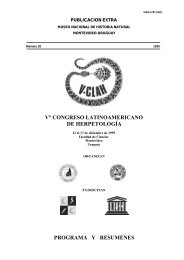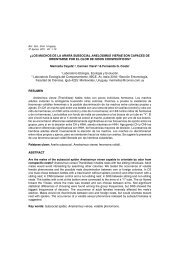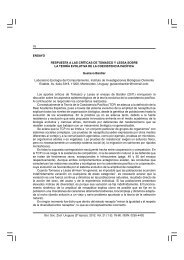Primer Congreso Uruguayo de Zoología - Sociedad Zoológica del ...
Primer Congreso Uruguayo de Zoología - Sociedad Zoológica del ...
Primer Congreso Uruguayo de Zoología - Sociedad Zoológica del ...
Create successful ePaper yourself
Turn your PDF publications into a flip-book with our unique Google optimized e-Paper software.
EVOLUTIONARY RADIATION OF PALEOZOIC LIMBED VERTEBRATESDr. Michel LaurinUMR 7207 (CNRS/MNHN/UPMC), Department ‘Histoire <strong>de</strong> la Terre’, CP 48, 43 rue Buffon, F-75231 Paris, Ce<strong>de</strong>x 05 – France.michel.laurin@upmc.frMuch recent progress has been ma<strong>de</strong> in un<strong>de</strong>rstanding stegocephalian origins. In addition to Pan<strong>de</strong>richthys andElpistostege, which had lost the dorsal and anal fins, the recent discovery of Tiktaalik further documents the origin ofthe stegocephalian body plan. Tiktaalik had lost the bony gill covers and a direct connection between skull andshoul<strong>de</strong>r girdle. Despite this recent discovery, the origin of digits is still poorly un<strong>de</strong>rstood; contrary to claims to thecontrary, a large morphological gap continues to exist between fins and limbs and preclu<strong>de</strong>s a <strong>de</strong>finitive statementabout the homology (or lack thereof) between the acropod (distal part of hands and feet) and the distal part of thefins. Hox gene expression patterns and <strong>de</strong>velopmental mo<strong>de</strong>ls also fail to resolve this issue. Pentadactyly appearedonly once, well before the divergence between amphibians and reptiliomorphs. Long-admitted i<strong>de</strong>as aboutstegocephalian phylogeny have been shown not to reflect the most parsimonious tree. Temnospondyls, which usedto be consi<strong>de</strong>red amphibians, and embolomeres and seymouriamorphs, which were formerly consi<strong>de</strong>redreptiliomorphs, are probably stem-tetrapods. Recent claims of a polyphyletic origin of extant amphibians, withanurans (and often uro<strong>de</strong>les) <strong>de</strong>riving from temnospondyls, and gymnophionans (and sometimes uro<strong>de</strong>les) <strong>de</strong>rivingfrom lepospondyls, are incompatible with recent phylogenies. In<strong>de</strong>ed, all recent matrices suggest that lepospondylsare more closely related to amniotes than to temnospondyls; hence, polyphyletic lissamphibians <strong>de</strong>rived fromlepospondyls and temnospondyls should be paraphyletic with respect to Amniota, yet no recent morphological,paleontological or molecular phylogeny recovers this topology. The new phylogenies imply that the tympanum ofanurans is a more recent structure than previously thought; it may have appeared in the Triassic, or possibly evenlater, rather than in the Late Carboniferous. Temnospondyls may not have had a tympanum, <strong>de</strong>spite severalassertions to the contrary. A review of the literature on environmental tolerance in early stegocephalians suggeststhat many of them tolerated saltwater and that saltwater intolerance is an autapomorphy of Lissamphibia. Ongoingwork on bone microstructure and other types of data (mostly taphonomic and morphological) suggests that theconquest of land by vertebrates required dozens of millions of years and was more complex than previously thought.It may have been <strong>de</strong>layed by an episo<strong>de</strong> of low atmospheric oxygen concentration, which may account for Romer’sgap. The first truly terrestrial vertebrates only happen after oxygen concentration rose again and reached orsurpasses its present concentration, in the late Mississippian.EXPLORING THE DIVERSITY AND ECOLOGY OF AMPHIBIAN SKIN CHEMICALSPhD(c) Valerie ClarkSchool of Pharmacy, Queen’s University in Belfast, Northern Ireland – UK. frogcaller@gmail.comAmphibian skin oozes a variety of substances that protect these animals from ecological challenges such as dryingout, bacteria, fungi, and predators. How these chemicals might affect frogs’ predators can be tested by conducting a‘quick lick taste test’ as a mock predator. Toxic frogs taste bitter or generally repulsive, and can cause a burning ornumbing sensation—this biological reaction means that the chemical(s) is/are acting on cell receptors, just like a‘drug.’ Over 50% of all drugs on the market were <strong>de</strong>veloped from natural sources, and amphibians represent a wealthof potential pharmaceutical leads. Some of these chemical substances are manufactured by amphibians, whereasothers are obtained from dietary sources or symbiotic bacteria. Brightly colored poison frogs that obtain alkaloidsfrom ants and other arthropod prey give us a shortcut to toxic insects that also serve as leads to <strong>de</strong>velop medicines.After providing a general overview of the field, a 5 minute vi<strong>de</strong>o on this research in Madagascar will be shown. Ourstudies on dietary alkaloid sequestration by tropical poison frogs will be <strong>de</strong>tailed, followed by photographs fromremote rainforests, with updates of ongoing and future research on the subject of amphibian chemical ecology.<strong>Primer</strong> <strong>Congreso</strong> <strong>Uruguayo</strong> <strong>de</strong> <strong>Zoología</strong> 39







